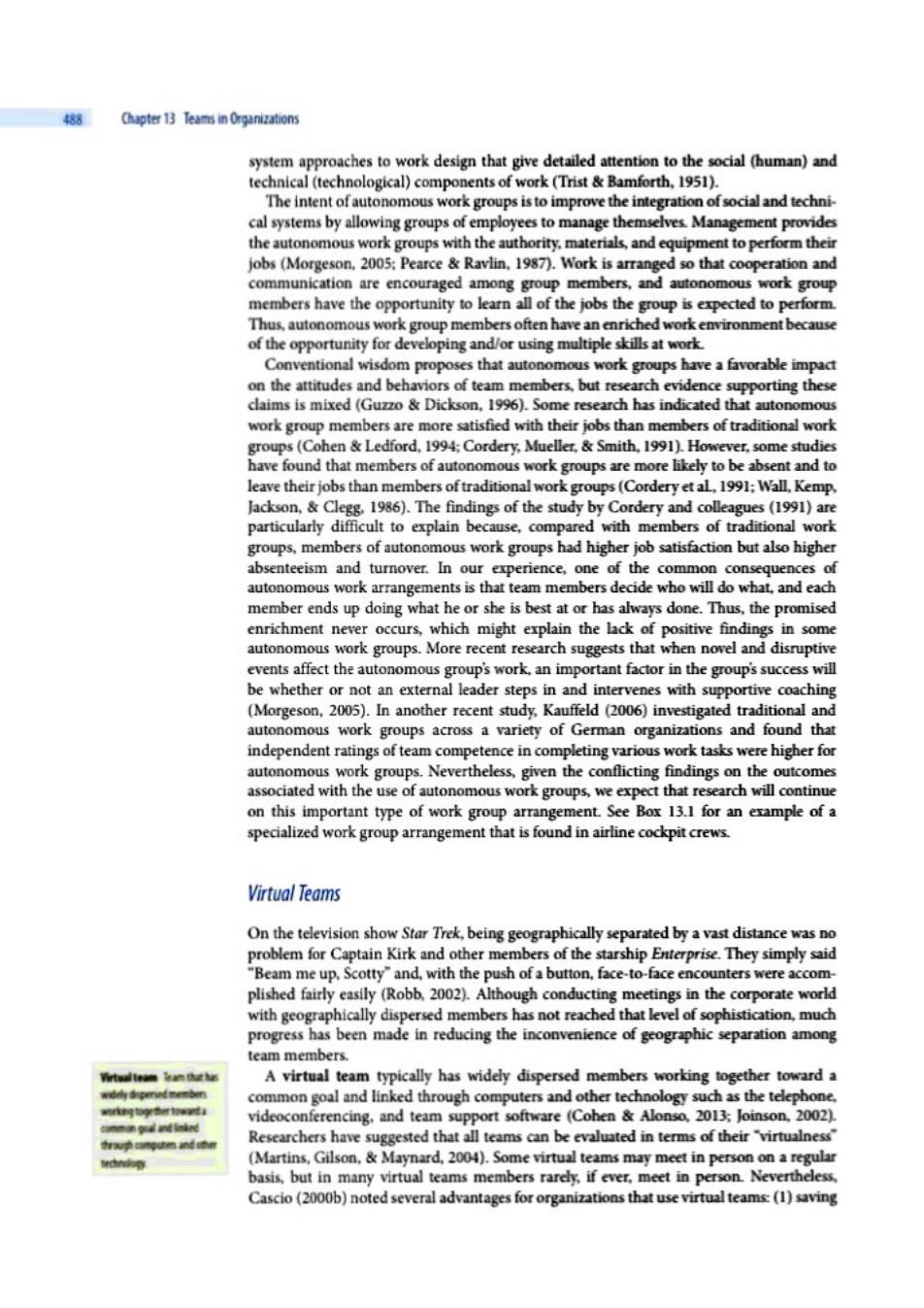正在加载图片...

488 Chapter 13 Teams in Organizations system approaches to work design that give detailed attention to the social (human)and technical (technological)components of work(Trist Bamforth.1951). The intent of autonomous work groups is to improve the integration ofsocial and techni- cal systems by allowing groups of employees to manage themselves Management provides the autonomous work groups with the authority.materials,and equipment to perform their jobs (Morgeson,2005;Pearce Ravlin,1987).Work is arranged so that cooperation and communication are encouraged among group members,and autonomous work group members have the opportunity to learn all of the jobs the group is expected to perform. Thus,autonomous work group members often have an enriched work environment because of the opportunity for developing and/or using multiple skills at work. Conventional wisdom proposes that autonomous work groups have a favorable impact on the attitudes and behaviors of team members,but research evidence supporting these claims is mixed (Guzzo Dickson,1996).Some research has indicated that autonomous work group members are more satisfied with their jobs than members of traditional work groups(Cohen Ledford,1994;Cordery,Mueller,Smith,1991).However,some studies have found that members of autonomous work groups are more likely to be absent and to leave their jobs than members oftraditional work groups(Cordery et al,1991:Wall,Kemp. Jackson,Clegg.1986).The findings of the study by Cordery and colleagues (1991)are particularly difficult to explain because,compared with members of traditional work groups,members of autonomous work groups had higher job satisfaction but also higher absenteeism and turnover.In our experience,one of the common consequences of autonomous work arrangements is that team members decide who will do what,and each member ends up doing what he or she is best at or has always done.Thus,the promised enrichment never occurs,which might explain the lack of positive findings in some autonomous work groups.More recent research suggests that when novel and disruptive events affect the autonomous group's work.an important factor in the group's success will be whether or not an external leader steps in and intervenes with supportive coaching (Morgeson,2005).In another recent study.Kauffeld (2006)investigated traditional and autonomous work groups across a variety of German organizations and found that independent ratings of team competence in completing various work tasks were higher for autonomous work groups.Nevertheless,given the conflicting findings on the outcomes associated with the use of autonomous work groups,we expect that research will continue on this important type of work group arrangement.See Box 13.1 for an example of a specialized work group arrangement that is found in airline cockpit crews. Virtual Teams On the television show Star Trek,being geographically separated by a vast distance was no problem for Captain Kirk and other members of the starship Enterprise.They simply said "Beam me up,Scotty"and,with the push of a button,face-to-face encounters were accom- plished fairly easily (Robb,2002).Although conducting meetings in the corporate world with geographically dispersed members has not reached that level of sophistication,much progress has been made in reducing the inconvenience of geographic separation among team members. A virtual team typically has widely dispersed members working together toward a common goal and linked through computers and other technology such as the telephone. videoconferencing.and team support software (Cohen Alonso,2013:Joinson.2002). Researchers have suggested that all teams can be evaluated in terms of their virtualness" (Martins,Gilson,Maynard,2004).Some virtual teams may meet in person on a regular basis.but in many virtual teams members rarely,if ever,meet in person.Nevertheless. Cascio(2000b)noted several advantages for organizations that use virtual teams:(1)saving